This article is produced and funded by NIKU Norwegian Institute for Cultural Heritage Research - read more.
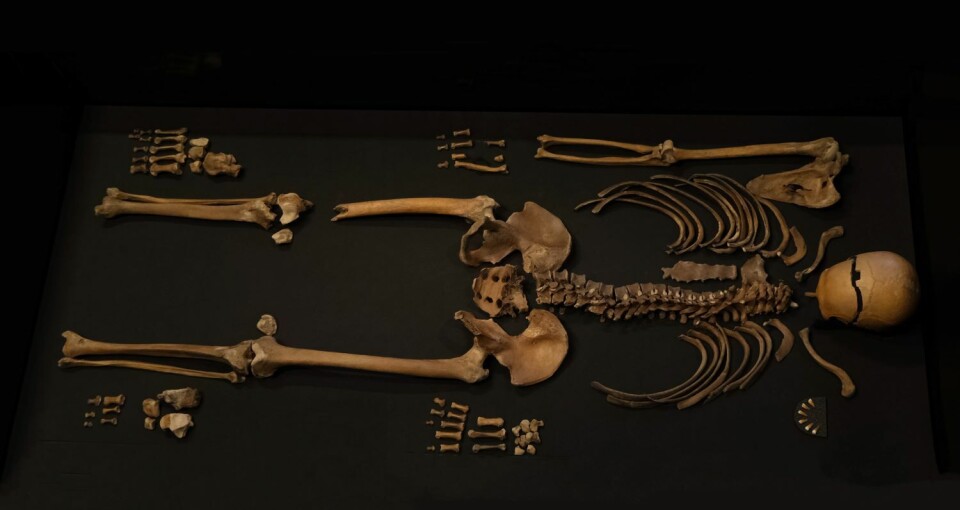
According to an Old Norse saga, a man was thrown into a well in 1197 to poison the water. Researchers can now reveal more about who he was
Analyses of the skeleton shed new light on a dramatic story.
According to Sverris Saga, a man was thrown into the well at Sverresborg castle in central Norway in the year 1197.
This was supposedly done by the Baglers. The intention was to poison the drinking water of the Birkebeiners.
In 1938, a skeleton was discovered in the well from the saga. It was then retrieved in 2016.
Analyses of this skeleton now shed new light on the dramatic history.
Researchers now know how old the man was, what he looked like, and where in Norway he was from.
Researchers have analysed the skeleton
"It's not often one gets the opportunity to compare physical remains from archaeological excavations with specific individuals from saga stories," says Anna Petersén.
She was NIKU's project manager for the excavations of the skeleton in 2014 and 2016.

A multidisciplinary collaboration between researchers from NIKU, NTNU University Museum, and others has now resulted in a scientific article published in the journal iScience.
Here, the researchers highlight the archaeological and historical context of the skeletal find. They also present the methods and results from the DNA analyses.
Their study is based on the genetic results of 'the man in the well' presented in a doctoral thesis from 2022.
With analyses of the skeleton performed by Hanne Ekstrøm Jordahl from NIKU and the results from the DNA analyses, the researchers now have a clear picture of what the man in the well looked like when he was alive.
The deed was described in Sverris Saga
The dramatic story took place during a raid on Sverresborg castle in 1197. It was described relatively shortly after in Sverris Saga:
'The Baglers took all the goods that were in the castle, and then they burned all the houses that were there. They took a dead man and threw him headfirst into the well, carried stones there and laid them over until it was full.'
The building of the castle was initiated by the Birkebeiner King Sverre around 1180 and placed on top of a flat rock knoll southwest of the medieval town of Trondheim in central Norway.
The king named the castle Sion, most likely after the Christian notion of Sion or Zion as the heavenly Jerusalem.

The castle complex consisted of at least one stone building. There were probably also many wooden buildings, but only one water source.
The inhabitants used a crevice in the rock with a natural water inflow.
During the Norwegian civil war (1130-1240), the Baglers made several attempts to capture the castle. However, the Birkebeiners held their ground until 1197.
The episode described in the saga tells of both the fate of the castle and the man.
The body that was thrown down the well by the Baglers was probably an attempt to poison the Birkebeiners' only drinking water source.
After the attack, the castle complex lay abandoned until attempts were made to rebuild it under Haakon Haakonsson (1204-1263), but the well was not completely cleared.
The skeleton in the well was first discovered in 1938
Fast forward to 1938. This headline could be read in Adresseavisen:
'Sensational historical find at Sverresborg. Skeleton at the bottom of the old well. The Baglers' victim who, according to the saga, was thrown into the well in 1197?'
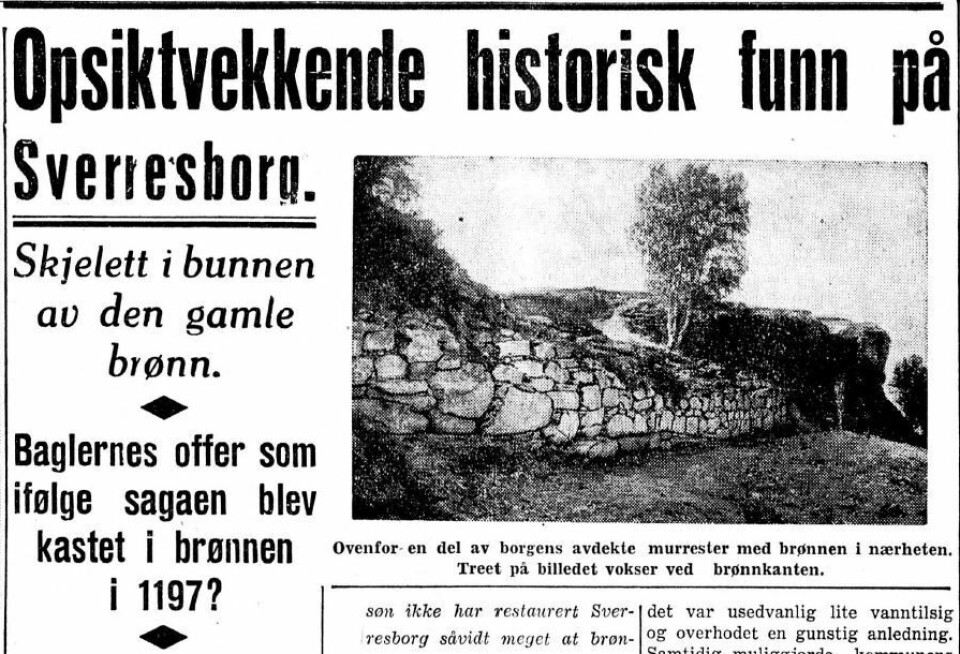
As part of a restoration project in the years 1936-1938, the well was excavated, and the skeleton was found. Architect Gerhard Fischer led the work.
In 1939, he specifically referred to the skeleton as 'the Birkebeiner.'
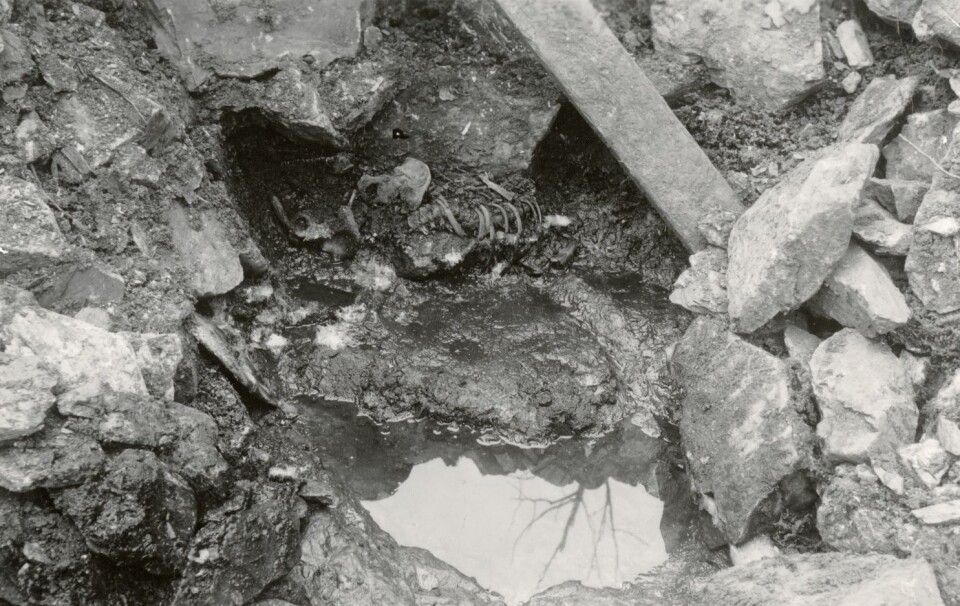
There is nothing in Sverris Saga that suggests the man was a Birkebeiner, but this perception has taken hold in history. The idea that the man belonged to the Trøndelag Birkebeiners has not been challenged - until now.
More on that later.
The plan was to excavate the well and retrieve the skeleton in the late 1930s, but a new dramatic war event put a stop to the entire excavation.
It would take another 80 years before this was done.
New archaeological investigations in 2014 and 2016
In 2014, the Norwegian Directorate for Cultural Heritage commissioned a smaller investigation by NIKU. The task was to examine the condition of the skeleton.
It was challenging. The hole was deep and water-filled, and documentation from Fischer's investigations had disappeared. It was also not known where in the well the skeleton was located.
It was also not known that the German forces during the occupation years used the well as a garbage dump. It was filled with large stones in addition to other debris.
However, within a week, the archaeologists managed to spot parts of the skeleton. They were wedged between large stones. The researchers retrieved parts that could form the basis for determining sex and age.
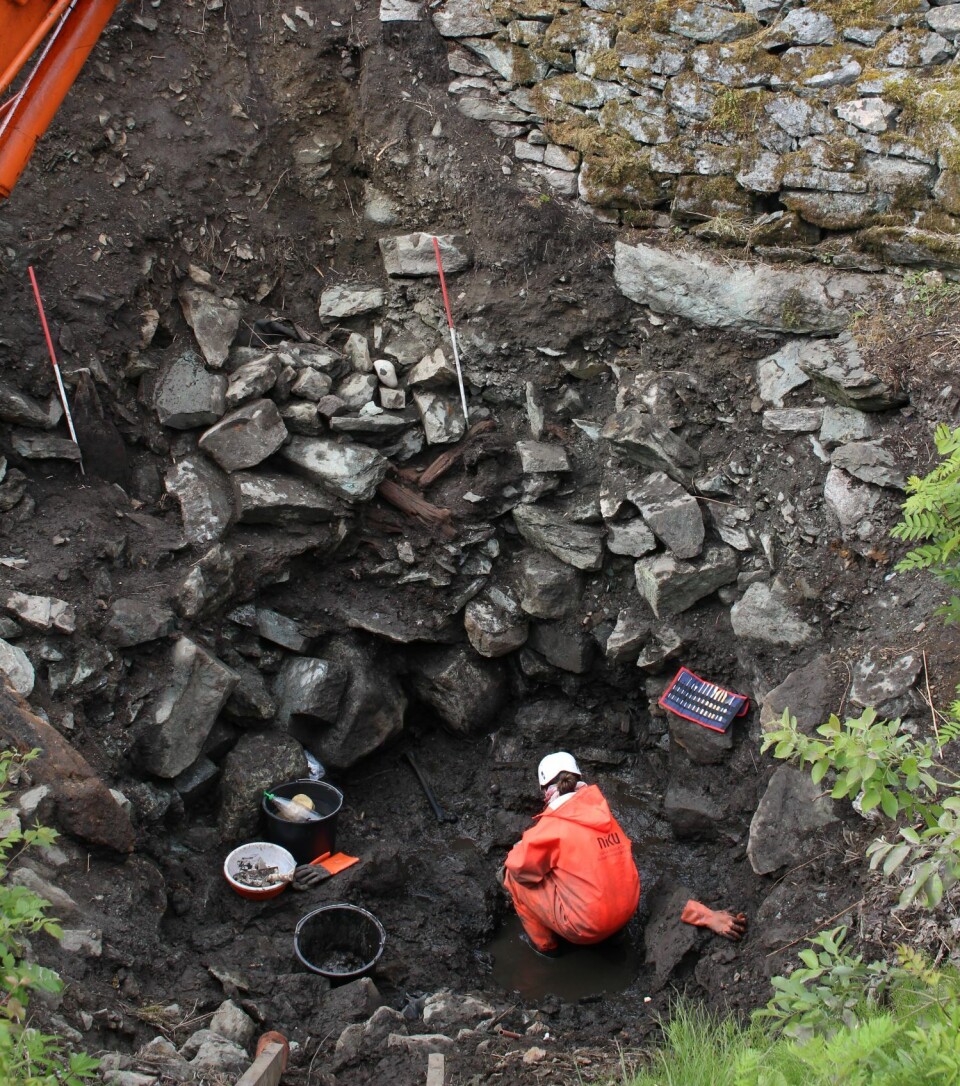
Analyses conducted by Sean Denham at the University of Stavanger showed that the remains came from a man in his 30s to 40s.
Additionally, the results of the radiological tests confirmed that the man lived at the time of the event described in the saga.
During a new and more comprehensive examination in 2016, the archaeologists were able to work more systematically.
The stones were carefully lifted out with the help of an excavator and manual labour. This allowed as much of the skeleton as possible to be documented in its original position before removal.
More than 90 per cent of the skeleton was recovered. A full analysis of the bones was conducted after the remains were retrieved.
A sturdy man
The brief saga description does not mention the man's appearance or age. It only states that he was dead when he was thrown into the well.
During the excavations, the skull was found some distance from the torso. The legs were twisted up towards the torso. The left arm was missing, but finger bones from the left hand were found.
The right foot still had a shoe on. This was the only trace of clothing found.
No traces of rope or textile were found that could indicate that the body had been bound or wrapped.
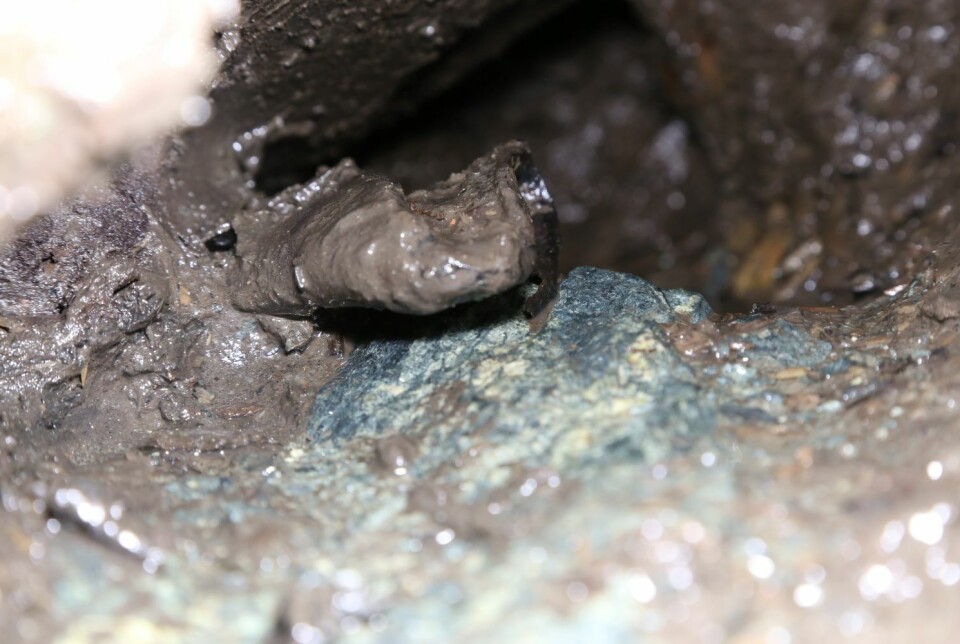
Hanne Ekstrøm Jordahl is an osteoarchaeologist and expert on human remains at NIKU. She has examined the skeleton.
"When he died, he was in his late 30s and was probably between 175 and 180 centimetres tall. That was quite a considerable height in his time," she says.

She further explains that his body was robust with pronounced muscle attachments on the arms and legs. His facial features were pronounced and masculine with a strong forehead and a somewhat prominent nose.
Several severe disease traits have been detected on the skeleton.
He had back problems and lung disease
Among other things, there were changes in the spine, and so-called pleural plaque (calcified lung lining) was visible on the inside of the chest. This may indicate that the man suffered from tuberculosis or so-called silicosis.
Overall, Jordahl's analysis shows that the man's health condition was poor. She believes it must have been both limiting and troublesome without him knowing the causes behind his physical ailments.
There were many injuries on the skeleton, and it is difficult to determine whether these occurred before, during, or after death.
Jordahl points to some injuries that are more likely to have occurred in connection with his death.
One of these is a crushing injury on the left side of the occipital bone, which has perforated the skull.
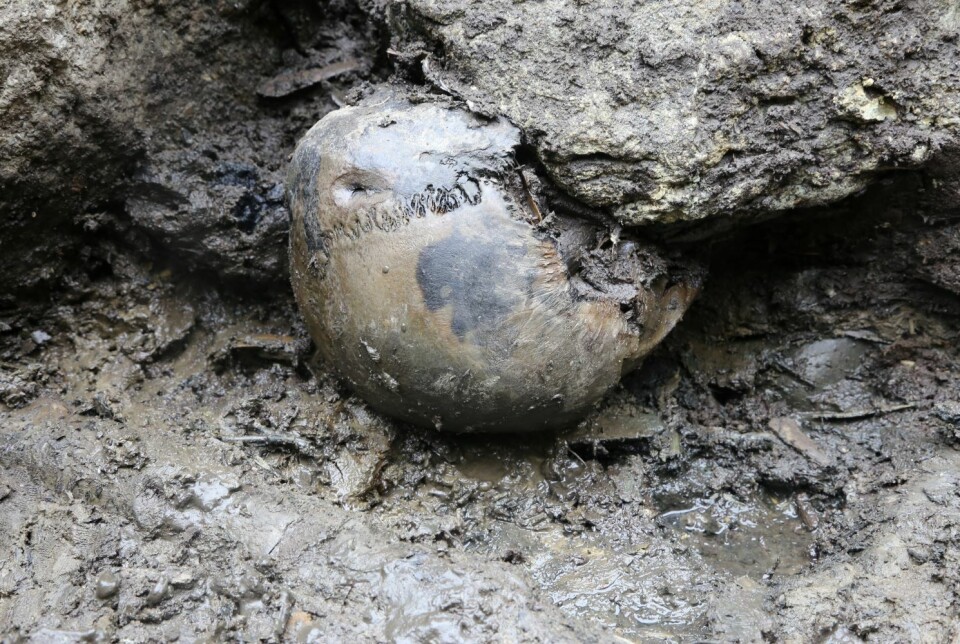
The blow might not necessarily have resulted in death, but unconsciousness and possibly a brain haemorrhage.
DNA analyses add substance to the findings
Martin Ellegaard had just started his PhD when Petersén contacted him and told him about the man in the well. The PhD was in population genetics and archaeological DNA at the NTNU University Museum.
Using new methods, combined with good craftsmanship in the laboratory and a good dose of stubbornness, Ellegaard finally managed to extract human DNA from a tooth.
And the results from the analyses were surprising: The man was blonde, blue-eyed, and from Agder in southern Norway.
Popular culture must take much of the blame for the notion of the stereotypical Norwegian as tall, fair-haired, and blue-eyed. The fact is that a thousand years ago, Norwegians looked different than they do now.
There were more migrants in Norway. Black hair and darker skin were therefore more common than they are today. It is only in recent times that the blonde and blue-eyed have become prominent.
The most unexpected result, however, was the man's geographical origin.
Was he not a Birkebeiner after all?
As previously mentioned, the man from Sverris Saga has been perceived as a Birkebeiner from Trøndelag. However, the saga text does not mention that specifically.
The background is probably the idea that the Baglers would hardly have thrown one of their own down a well, but would have given him a dignified burial.
The DNA results, however, showed that the man was unequivocally from Agder and not from Trøndelag.
This raises new questions. Was the man not a Birkebeiner after all? Or were the Birkebeiners a group of people from different geographical areas? Did the man work as a stonemason at the castle? Did he come between the Birkebeiners and the Baglers and become a random victim?
The DNA analyses do not provide answers to these questions.
Unique results
Professor Michael Martin at NTNU was Ellegaard's supervisor during his doctoral studies. He explains the significance of the results:
"As far as we know, this is the oldest case where genomic information has been obtained from a specific person mentioned in old historical sources."
Genomics is the study of all genes in an organism to understand their molecular organisation, function, interaction, and evolutionary history.
By analysing such information from the skeleton, researchers have been able to uncover new details about the person, such as his physical characteristics and relations to other populations.
Martin explains that the details in the study enrich the story from Sverris Saga by adding information that is not found in the historical text.
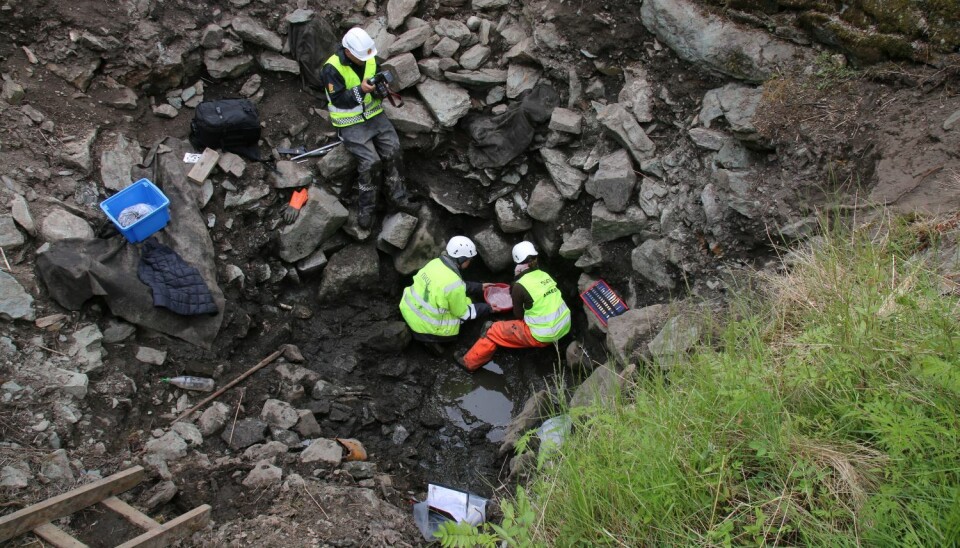
Eventually, more genetic and isotopic data will be collected from both current populations and ancient skeletal remains. This interdisciplinary approach can then be used to physically describe and reconstruct the life stories of the otherwise anonymous individuals whose remains are found at archaeological excavations.
"This can include details such as their movements between different geographical regions, which can give us a better understanding of their lives and societies," he says.
From 'the man in the well' to 'the man from Agder'
The man who ended his days at the bottom of a well has until now been an anonymous individual.
The researchers' new results have now helped bring the man out of history's darkness. It has restored some of the character he had as a living person.
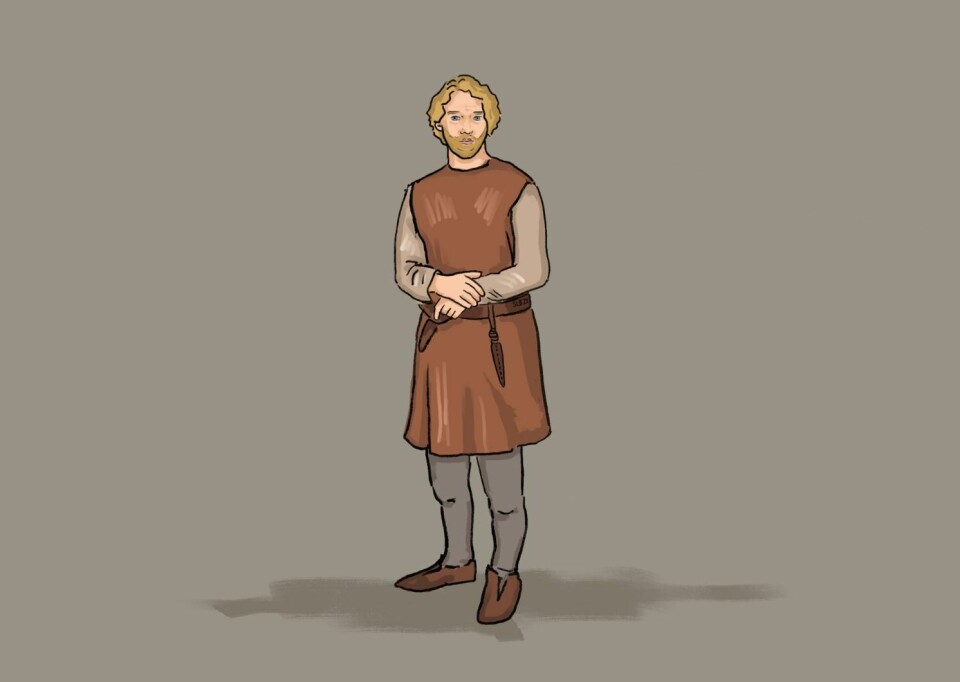
There are no other written sources than the text in Sverris Saga that relate to the find in the well. Information gathered from archaeology, and in this case genetic analyses, has been important in assessing the truthfulness of the text.
Everything indicates that the dramatic episode from Sverris Saga really happened.
"Our man is a rare coincidence between reality and a historical description of an event. But whether he belonged to the Birkebeiners or the Baglers, or was a random victim, remains unknown," says Petersén.
Now that the human remains are no longer in the well, and we know a good deal more about the individual from Sverris Saga, we might start calling him 'the Agder man' instead of 'the man in the well.'
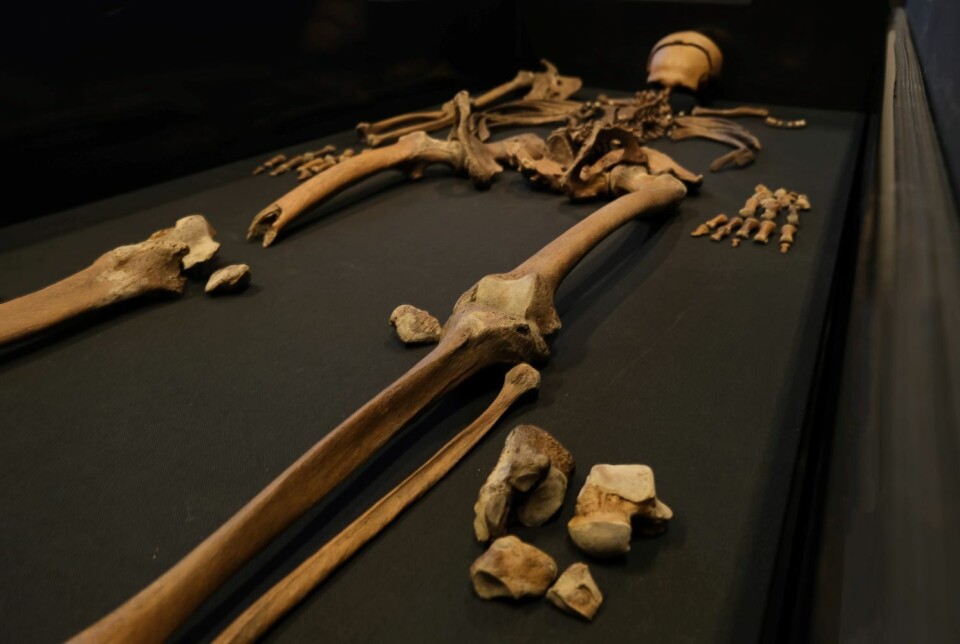
The man from Agder is currently on display at the NTNU University Museum.
References:
Denham, S.D. & Westling, S. Osteological and paleobotanical investigations of skeletal and soil sample from Sverresborg, Trøndelag Folkemuseum, Trondheim, Sør-Trøndelag, Report from the University of Stavanger, 2014.
Ellegaard, M.R. 'Human Population Genomics in Northern Europe in the Past 2000 years', Doctoral thesis at NTNU, 2022. (Abstract)
Ellegaard et al. Corroborating written history with ancient DNA: The case of the Well-man described in an Old Norse saga, iScience, 2024.
Petersén, A. Påvisningsundersøkelse av menneskelige levninger i brønn på det middelalderske borganlegget Sverresborg i Trondheim TA 2014/21. Sverresborg borgruin, Trondheim kommune, Trøndelag (Exploratory investigation of human remains in a well at the medieval fortress Sverresborg in Trondheim TA 2014/21. Sverresborg castle ruins, Trondheim municipality, Trøndelag), Report from NIKU, 2023.

This content is paid for and presented by NIKU - Norwegian Institute for Cultural Heritage Research
This content is created by NIKU's communication staff, who use this platform to communicate science and share results from research with the public. NIKU is one of more than 80 owners of ScienceNorway.no. Read more here.
More content from NIKU:
-
Archaeologists have uncovered a long-lost medieval market town at Hamar
-
Swedish King Charles XII transported massive ships overland to attack a Norwegian fortress. Researchers have now uncovered the forgotten route
-
This robot is on the hunt for Norway's hidden cultural heritage
-
Promising results with ground-penetrating radar in Iceland
-
The Gjellestad burial mound belonged to the Iron Age elite
-
How Climate Change is threatening Heritage in the Arctic
Petersén et al. Arkeologisk undersøkelse av brønnen på Sverresborg borgruin og opptak av skjelett. TA 2016/14. Sverresborg borgruin, Sverresborg Museum, Trondheim (PDF) (Archaeological investigation of the well at Sverresborg castle ruins and retrieval of skeleton. TA 2016/14. Sverresborg castle ruins, Sverresborg museum, Trondheim), Report from NIKU, 2024.





































